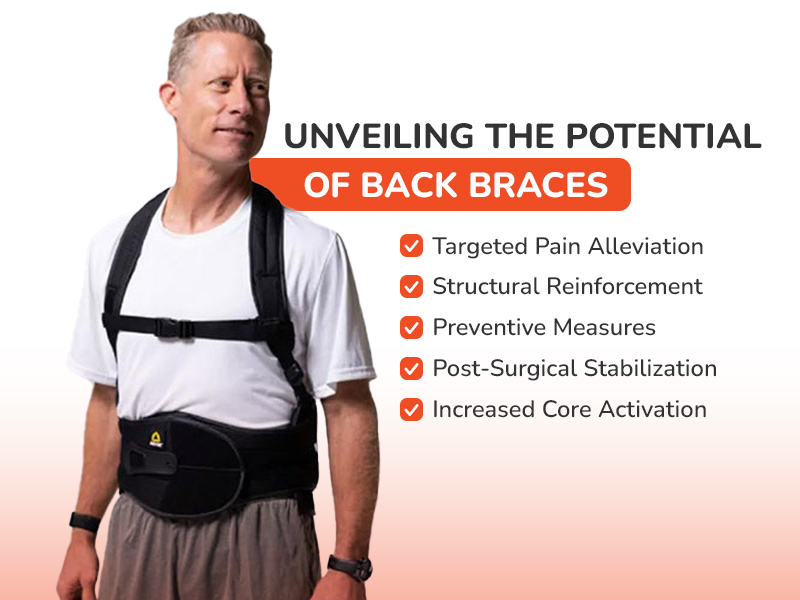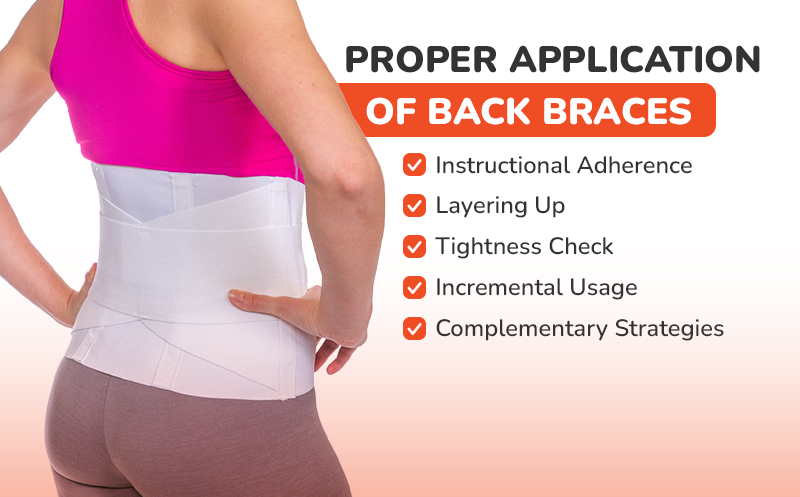Mastering Back Brace Selection and Usage for Optimal Health
When back pain strikes, relief and support become paramount; a back brace is often the unsung hero for many, providing the necessary reinforcement to navigate daily life easily. However, the question remains: how does one choose and properly use a back brace? In this in-depth guide, we explore the integral role of back braces in spinal health management, offering insight into their selection, benefits, and maintenance for an empowered and pain-free lifestyle.
Unveiling the Potential of Back Brace
The strategic application of a back brace can be a life-altering decision for individuals coping with back issues, offering multi-faceted benefits that extend beyond mere symptom management:

- Targeted Pain Alleviation: Back braces are meticulously designed to restrict movement in painful areas as a buffer against the jarring motions exacerbating back discomfort. By immobilizing the affected region, these braces provide a comforting sensation, allowing for pain relief that can be felt almost immediately upon wear.
- Structural Reinforcement: Back braces distribute the upper body’s weight more evenly as a scaffold for the spine. They assist in maintaining an upright posture, which is essential for aesthetic and functional reasons, ensuring that the spine is in its natural alignment, thereby reducing the risk of further injury and long-term wear and tear.
- Preventive Measures: Prevention is better than cure, and this adage holds in the realm of back health. For individuals whose lifestyle or occupation puts them at risk of back strain or injury, a back brace can be an indispensable tool, providing the necessary support to prevent such occurrences.
- Post-Surgical Stabilization: In the aftermath of spinal surgery, the body requires an environment conducive to healing. Here, back braces shine, an integral part of the post-operative care regimen. They minimize stress on the surgical site, ensuring the spine remains stable and properly aligned, which is critical for a successful recovery.
- Increased Core Activation: A less commonly noted advantage of wearing a back brace is the potential for increased core muscle activation. Some brace designs encourage the engagement of abdominal muscles to compensate for the brace’s support, thus promoting stronger core development over time. However, this benefit depends on the type of brace and how it is used.
Delving into the Diversity of Back Brace
The landscape of back braces is diverse, with each variety crafted to fulfil a specific role in the maintenance, rehabilitation, or enhancement of spinal health:
- Elastic Braces: Elastic back braces are the quintessential aides for those who require a soft touch of support. Crafted from stretchable materials, they snugly wrap around the midsection, providing gentle compression. This compression stabilizes the core and reminds the wearer to keep their posture in check – a subtle yet effective nudge to avoid slouching or bending improperly during daily activities.
- Hard Braces: On the other end of the spectrum are the hard braces – the robust custodians of spinal integrity. These braces are constructed from rigid materials and offer crucial immobilization in severe back trauma or postoperative recovery cases.
- Hybrid Braces: The hybrid back braces bridge the gap between flexibility and firmness. These innovative designs feature robust panels for structural support paired with elastic straps that confer a degree of adjustability. The hybrid brace is an adaptable solution suited to those who may need to transition between levels of support as they journey through different stages of recovery or pain management.
- Adjustable Braces: Adjustable braces cater to a wide array of back conditions, allowing the user to customize the fit and level of compression. These braces often come with Velcro straps or lacing systems that can be tightened or loosened as needed, ensuring that the user can tailor the brace’s function to their comfort and support requirements throughout the day.
- Specialty Braces: Special braces are also designed for specific conditions, such as scoliosis or osteoporosis. These are often custom-fitted and have features tailored to address unique anatomical and medical needs, ensuring that the support provided is as effective as possible in managing the specific spinal condition.
Criteria for Back Brace Selection
The options can be overwhelming when you’re looking for a back brace. However, focusing on key selection criteria can help you find the ideal match for your spinal care needs. Here’s what to keep in mind:
- Professional Guidance: Before venturing into the array of back brace options, seek the insight of a healthcare professional. Their expertise can steer you towards a brace that targets your specific back issue, whether it’s for chronic pain management, post-surgical recovery, or injury prevention.
- Function over Fashion: While choosing a brace for its sleek design is tempting, priority should be given to its therapeutic value. The main question should be: How will this brace alleviate my condition or protect my spine? The aesthetic appeal of the brace is secondary to its ability to deliver relief and support. After all, the true beauty of a back brace lies in its functionality and the comfort it brings to your daily life.
- Fitting Matters: A back brace must fit like a second skin—snug enough to offer support yet flexible enough to allow movement. An ill-fitting brace can do more harm than good by failing to provide sufficient support or causing discomfort and potential skin irritation. Precision in fit maximizes the brace’s efficacy and ensures that wearing it becomes a seamless part of your routine.
- Material Matters: The materials used in a back brace are critical to ensure that it can be worn comfortably for the required duration. Fabrics should be durable to withstand daily wear and tear, breathable to prevent overheating and moisture buildup, and gentle on the skin to minimize the risk of irritation.
- User-Friendliness: The best back brace is one that you can easily incorporate into your life. It should be simple to put on and remove, with straightforward and secure closures. Consider how the brace accommodates your lifestyle—can you wear it discreetly under clothing? Is it easy to adjust on the go? A user-friendly brace encourages consistent use, which is key to experiencing its full therapeutic benefits.
Read More: How Often Will Medicare Pay for Back Braces?
Proper Application of Back Brace
To fully benefit from a back brace, one must adhere to best practices in its application:

- Instructional Adherence: It’s crucial to begin with a thorough reading of the instructions provided with your back brace. Manufacturers design these guidelines to optimize the support and relief the brace offers. This includes details on adjusting the straps and correctly positioning the brace for maximum effectiveness.
- Layering Up: Before fitting the brace, ensure a comfortable, thin layer of clothing between the brace and your skin. This helps prevent skin irritation from prolonged contact and absorbs sweat, keeping the brace cleaner. Choose a moisture-wicking fabric for additional comfort, especially if you wear the brace for extended periods.
- Tightness Check: The fit of the brace should be snug enough to feel the support without it causing any discomfort. If it’s too tight, it can interfere with circulation and cause discomfort or even swelling. Conversely, a brace that’s too loose won’t provide adequate support.
- Incremental Usage: For those new to wearing a back brace, it’s important to acclimate the body to its support. Start by wearing the brace for short periods and gradually increase the duration as your body becomes accustomed to it. This helps your body adjust to the additional support and prevents dependency on the brace for muscle function.
- Complementary Strategies: A back brace should be part of a comprehensive approach to back care. It’s not a standalone solution. Incorporate core strengthening exercises, stretches, and proper ergonomics in your daily routine to improve muscle strength and flexibility. A balanced approach ensures that the brace is a tool for relief and recovery, not a crutch that leads to muscle atrophy.
Sustaining Your Back Brace
Proper care of your brace is tantamount to sustaining its efficacy:
- Cleaning Protocol: The longevity and effectiveness of your back brace largely depend on how well it’s maintained. To prevent the buildup of sweat, oils, and skin particles that can degrade the material and reduce the brace’s comfort, adhere to the manufacturer’s cleaning protocol. This often involves using mild detergents, hand washing, and air drying to avoid warping or stretching the brace’s components.
- Regular Inspections: Examining your back brace for signs of wear and tear is essential. Look for stretched straps, frayed edges, or any breakdown in the material that could compromise the brace’s integrity. Detecting issues early allows for timely repairs or replacements before affecting the brace’s support.
- Storage Practices: When not in use, store your brace in a cool, dry place out of direct sunlight to prevent material degradation. The environment in which the brace is kept can affect its shape and functionality. Avoid folding or crumpling the brace, which can lead to creases or damage to its structure.
Knowing When to Seek Help
While a back brace can be a valuable asset, it’s not a panacea:
- If pain intensifies or doesn’t subside with brace use, consult a healthcare provider.
- Lack of improvement or worsening symptoms necessitates professional intervention.
- Uncertainty about brace usage should prompt a visit to a specialist.
Conclusion
Back braces are more than just a bandage for back ailments — they are pillars of support for those seeking to maintain or regain spinal health. With the right selection, consistent use, and proper care, a back brace can be instrumental in leading a more comfortable and active life. Embrace the brace, and walk into a future where back pain does not dictate your day.



